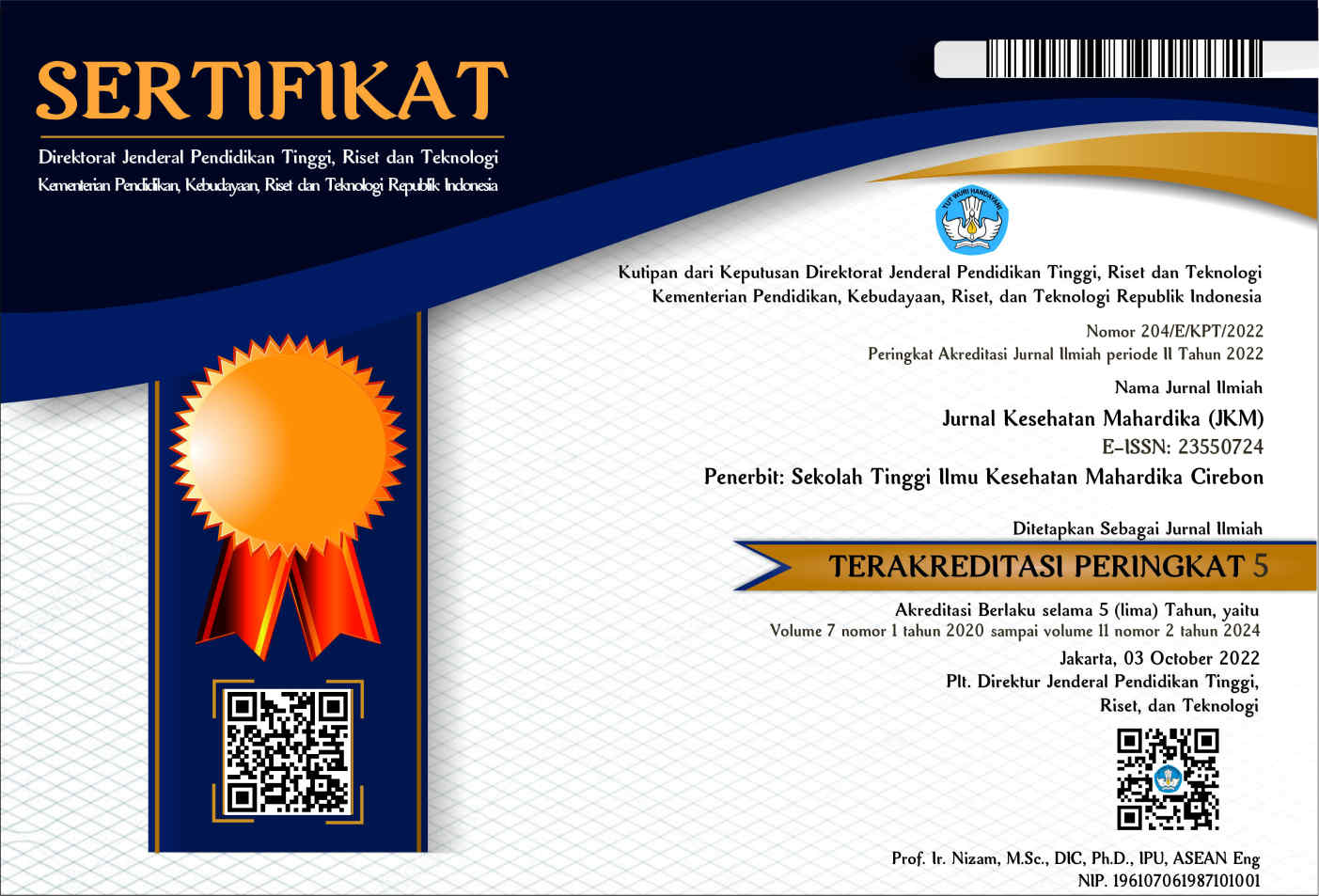The Description of Gamma Glutamyl Transferase Levels in Lung Tuberculosis Patients with Anti-TB Drug Therapy at Puskesmas Wonorejo
Keywords:
Anti tuberculosis drug, Drug Induced Liver Injury, Gamma Glutamyl Transferase, Lung TBAbstract
Consume the anti tuberculosis drug for long term causes Drug Induced Liver Injury by hepatotoxicity, so that need Gamma Glutamyl Transferase test to help diagnose liver condition. The aim of research is knowing description of lung tuberculosis patients’s GGT at Puskesmas Wonorejo by gender, age, and length of treatment. The method of research is description observational with cross-sectional. Samples used 17 patient's serum of lung TB with anti tuberculosis drug treatment at Puskesmas Wonorejo on July 2023-2 April 2024. GGT levels were above normal in 10 patients (59%), GGT levels were normal in 7 patients (41%). More female patients had GGT levels above normal than men 6 patients (35.3%), highest average GGT level in men 42 U/L. More adult patients had GGT levels above normal 5 patients (29%), highest average GGT level in elderly 45 U/L. More intensive stage patients had GGT levels above normal than advanced stage 7 patients (41%), highest average GGT level in intensive stage 46 U/L. The conclusion is the highest average GGT levels in elderly men with intensive stage.
References
Agustian, M. D., & Masria, S. (2022). Hubungan Usia, Jenis Kelamin dan Tingkat Pendidikan dengan Kejadian TB Paru di Wilayah Kerja Puskesmas Cibadak Kabupaten Sukabumi. Bandung Conference Series: Medical Science, 2(1), 1120–1125.
Chang, K. C., Leung, C. C., Yew, W. W., Lau, T. Y., & Tam, C. M. (2008). Hepatotoxicity of pyrazinamide: cohort and case-control analyses. American Journal of Respiratory and Critical Care Medicine, 177(12), 1391–1396.
Clarasanti, I., Wongkar, M. C. P., & Waleleng, B. J. (2016). Gambaran enzim transaminase pada pasien tuberkulosis paru yang diterapi dengan obat-obat anti tuberkulosis di RSUP Prof. Dr. RD Kandou Manado. E-CliniC, 4(1).
Depkes RI. (2007). Pharmaceutical Care untuk Penyakit Hati. Jakarta: Departemen Kesehatan RI.
Dinkes Kota Samarinda. (2023). 10 Besar Penyakit di Samarinda TW II. Retrieved September 20. Dinkes Kota Samarinda: Samarinda.
Diskominfo Prov. Kaltim. (2022). Tiga Kabupaten dan Kota di Kaltim Tertinggi Kasus TBC. Diperoleh dari https://diskominfo.kaltimprov.go.id/kesehatan/tiga-kabupaten-dan-kota-di-kaltim-tertinggi-kasus-tbc
Ghadban R, Staros EB. (2013). Gamma-Glutamyltransferase [Internet] Available from: http://emedicine.medscape.com/article/2087891-overview
Gumay, B. S., & Mustofa, S. (2020). Penggunaan Klinis Aktivitas Enzim Gamma-Glutamyl Transferase (GGT) Plasma dan Potensinya sebagai Biomarker untuk Berbagai Penyakit. MAJORITY, 9(1), 167–173.
Haurissa, A. E. (2014). Gamma-glutamyltransferase sebagai biomarker risiko penyakit kardiovaskuler. Cermin Dunia Kedokteran, 41(11), 816–818.
Kementerian Kesehatan RI. (2019). Keputusan Menteri Kesehatan Republik Indonesia Nomor HK. 01.07/MENKES/755/2019 tentang Pedoman Nasional Pelayanan Kedokteran Tata Laksana TB. Retrieved September 04, 2023, from https://yankes.kemkes.go.id/.
Khushboo Ambreen. (2014). Anti-Tuberculosis Drug-Induced Hepatotoxicity: A Review. International Journal of Advanced Biotechnology and Research(IJBR), 5(3), 423–437.
Konde, C. P., Asrifuddin, A., & Langi, F. L. F. G. (2020). Hubungan antara umur, status gizi dan kepadatan hunian dengan tuberkulosis paru di Puskesmas Tuminting Kota Manado. KESMAS, 9(1).
Lestari, Novia Dwi. (2020). Systematic Literature Review: Gambaran Kadar Gamma-Glutamyl Transferase (GGT) pada Penderita Tuberkulosis dengan Pengobatan Lebih dari 1 Bulan. Institut Ilmu Kesehatan BW Kediri, accessed April 27, 2024, https://oasis.iik.ac.id:9443/repo/items/show/8949
Loho, I. M., & Hasan, I. (2014). Drug-induced liver injury–tantangan dalam diagnosis. Cermin Dunia Kedokteran, 41(3), 167–170.
Mitchell, J. R., Zimmerman, H. J., Ishak, K. G., Thorgeirsson, U. P., Timbrell, J. A., Snodgrass, W.R., & Nelson, S. D. (1976). Isoniazid liver injury: clinical spectrum, pathology, and probable pathogenesis. Annals of Internal Medicine, 84(2), 181–192.
Purwanto, T., & Sangging, P. R. A. (2023). Etiologi, Patofisiologi, Evaluasi, dan Tatalaksana Drug Induced Hepatotoxicity. Medical Profession Journal of Lampung, 13(3), 322–326.
Ramappa, V., & Aithal, G. P. (2013). Hepatotoxicity related to anti-tuberculosis drugs: mechanisms and management. Journal of Clinical and Experimental Hepatology, 3(1), 37–49.
Rokhmah, D. (2013). Gender dan Penyakit Tuberkulosis: Implikasinya Terhadap Akses Layanan Kesehatan Masyarakat Miskin yang Rendah. Kesmas, 7(10), 447–452.
Soedarsono, S., & Riadi, A. R. W. (2020). Tuberculosis drug-induced liver injury. Jurnal Respirasi, 6(2), 49–54.
Sotaniemi, E. A., Arranto, A. J., Pelkonen, O., & Pasanen, M. (1997). Age and cytochrome P450‐linked drug metabolism in humans: an analysis of 226 subjects with equal histopathologic conditions. Clinical Pharmacology & Therapeutics, 61(3), 331–339.
Tabrani, Rab. (2010). Ilmu Penyakit Paru. Jakarta: Trans Info Media.
Vroon, D. H., & Israili, Z. (1990). Aminotransferases. In H. K. Walker (Eds.) et. al., Clinical Methods: The History, Physical, and Laboratory Examinations. (3rd ed.). Butterworths
Published
How to Cite
Issue
Section
Copyright (c) 2024 Jurnal Kesehatan Mahardika

This work is licensed under a Creative Commons Attribution-NoDerivatives 4.0 International License.













